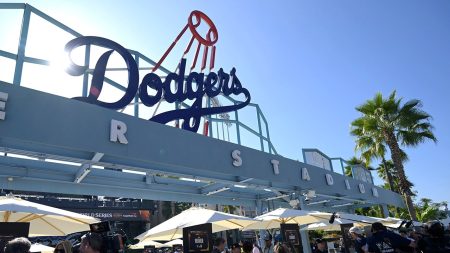In the realm of Major League Baseball, a potential new rule known as the “Golden At-Bat” is causing a stir among team owners and fans alike. This innovative approach, as shed light on by Commissioner Rob Manfred during an October podcast appearance, would grant each team the opportunity to elevate one player to the plate regardless of their current batting order. The rule aims to bolster the intensity of late-game situations and potentially swing the outcome in crunch-time moments. For instance, if the Los Angeles Dodgers found themselves with two outs and were trailing by a run with an underperforming player due up, they could opt to have their star player, like Shohei Ohtani, take an earlier turn at bat using this special provision. The idea has captured attention and discussions among league officials as the Winter Meetings approach.
The proposed rule could serve as a game-changer, marking one of the most significant adjustments to the rules in recent years. Baseball has seen several notable changes ahead of the 2023 season aimed at improving game pace and overall excitement, including larger bases, the introduction of a pitch timer, limitations on defensive shifts, and restrictions on pitchers’ pickoff attempts. While traditionalists often react negatively to any adjustments to the game’s structure, the results speak for themselves. The latest measures have contributed to shorter average game times, with nine-inning contests clocking in at just two hours and thirty-six minutes, the shortest since 1984. Moreover, the game witnessed a resurgence in stolen bases, highlighting the effectiveness of these changes in generating a more dynamic playing environment.
This rule ultimately aims to enhance the entertainment factor of the game by generating thrilling scenarios, especially as games reach their defining moments. For example, the potential for a high-profile player like Ohtani to step up to the plate during a nail-biting ninth inning could create compelling narrative arcs that engage fans more deeply. Despite the adversity faced by teams like the Dodgers, the ability to designate an elite player for a crucial at-bat might lead to excessively dramatic and memorable baseball moments, evoking excitement and enthusiasm in crowds. The league’s willingness to adapt is indicative of its commitment to not only preserving the sport’s integrity but also ensuring it remains relevant and captivating amid shifting societal interests toward sports entertainment.
While the concept of the Golden At-Bat has garnered interest, there are various interpretations being debated among stakeholders. Some discussions suggest that the provision could be limited to specific instances in the game, such as only during the ninth inning or after the seventh, which would introduce a strategic element to its deployment. The diversity in proposed variations underscores the complexity of implementing rule changes that will satisfy both purists who advocate for traditional game play and modern fans who crave excitement. The ultimate aim of the league is to strike a balance that keeps the competitive nature of the game intact while embracing innovations that resonate with younger audiences increasingly drawn to more fast-paced sports.
As MLB continues to navigate the balance between tradition and innovation, it is essential to consider the impact of prior changes on attendance figures and viewership. The league observed its highest attendance rates since 2017, with numerous fans flocking to stadiums despite increasing ticket prices. This likely indicates that fans are responding positively to the recent rules aimed at increasing action on the field and reducing downtime. By maintaining this upward trend in spectator involvement, Major League Baseball can solidify its reputation not just as America’s pastime but also as a dynamic sport capable of adapting to the evolving landscape of competitive athletics.
In conclusion, the discussions surrounding the Golden At-Bat rule reflect a broader trend within Major League Baseball to engage audiences and maintain relevance in a competitive sports landscape. While the idea has faced criticism from traditionalists who may view it as a deviation from the game’s essence, the results from previous adjustments provide a strong argument for such innovations. Ultimately, the goal of enhancing the game experience while ensuring excitement and dynamism on the field remains paramount. As the league heads into the Winter Meetings, the potential for groundbreaking changes like the Golden At-Bat could lead to a transformation of how the game is played and experienced, ushering in a new era of baseball that captivates fans old and new.










